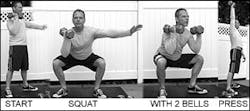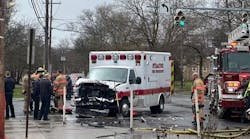Ironically, as the country begins to abandon the standard fire department physical entry level physical or CPAT (Candidate Physical Abilities Test), the New York City Fire Department has recently adapted a classic CPAT. This represents major a break from previous hiring procedures, largely in that it uses a pass/fail marking system. To pass any CPAT, click here.
A graded exam (versus pass/fail) affects list number placement and ensures the most physically capable staff, while a pass/fail system can allow mediocrity to become the norm. New York is a big city, and the FDNY can hire one thousand each year. As an expert on firefighter fitness, I feel this is a major step in the opposite direction, as units in the field must now rely heavily on the prestigious FDNY Training Academy to produce the type of probie it has taken for granted in the past.
I've heard the question a dozen times, from chief and company officers from around the country who've found themselves in charge of a firefighter training academy: "How does the FDNY produce such great recruits, and why do we have so much trouble with our probationary firefighters?"
I answer their question with a question: "Is your entrance physical graded or pass/fail?" But I already know the answer. Raise entry level standards to produce a more-capable probie, both academically and physically. One of the best ways to raise physical standards is to give an abilities test that's graded.
In the Big Apple, training has now become even more important. No longer will the FDNY field units have the luxury of having one super-fit probie after the next show up at their door step. It's up to the training academy, which will be lengthened to six months to acclimate the less-capable recruit, to transform each individual into a professional and physically prepared firefighter.
If you aspire to become a career firefighter and have plans to test in the near future, don't stop at the CPAT. Continue training with a sensible program that includes a long range plan which carries you through the academy and well beyond. With physical standards dropping in the largest department on earth, it's now up to the individual to get serious about his or her own current physical condition and ability to perform under extreme pressure.
CPAT Prep: Start-up Workout
In order to pass the typical 10 minute and 20 second CPAT, it's most important to develop both strength AND endurance. Strength-endurance is a relatively new concept that's been circulating through the functional fitness arena. Think of strength-endurance as strength that endures. Pure cardio routines that feature endless running will not help you climb multiple flights of stairs with 75 pounds on your back. Nor will setting a personal best record on your bench press.
The best way to first tap into this elusive quality is with a simple combination approach, utilizing movement strategies that continually vary the demand placed on all your muscles and cardiovascular system. Don't confuse this will isolated high-rep exercises (IE: Bicep Curl) designed to hyper-trophate muscle as its sole purpose.
Later, once a certain level of expertise and conditioning takes place, these movements can actually be integrated with mock-test events (example: vested stepping for the typical step mill test) with supersets (alternating between sets of each exercise with little, if any rest).
Strength/Endurance Combination Exercise # 1
The Squat / Overhead Press (one arm or two arm)
Remember, we're not trying to beat a world record here. Grab a pair of light dumbbells to get started. Kettlebells, my personal favorite, make an even better choice. Most of us don't know how to bring a dumbbell to shoulder level without arching the back and leaning under the weight (as in a "cheat curl"). Don't do that. Instead, follow the below instructions, which can be done as one or two arm variations, all else remains the same. (see photo above)
The Stance
Stand with your feet a little wider than hip width apart, toes pointed slightly out. Bend from the hips first (knees will follow) and pick up one bell in each hand. Your back stays straight (don't even think of rounding your back here) and weight stays on the heels. Let your hips hinge and keep your butt back. Keep your shins as vertical as possible (do not let the knees extend past your toes or collapse inward).
Your back stays straight as you push through the heels (exhaling) and stand up, locking out with the hips and knees. With the momentum generated from the hip thrust, it will cause the dumbbells you're holding to arc up. Just assist with the arms, allowing both bells to arrive safely at shoulder level.
Make sure you didn't arch your back and scoop under the weight, instead tighten the buttocks, quads and abdominal muscles, creating a virtual belt around your midsection. You should now have both bells in the "racked" position at each shoulder. Elbows are down and against your ribs, palms face toward your body. It's okay to use your body to help support the weight. Allow your shoulders to stretch down as in a reverse shrug.
The Squat
Create some tension in your body and stand strong. Your abs and glutes need to be contracted in this position. Next it's time to squat down. Think of the squat as originating from the hips hinging, not the knees. Inhale as you don't just lower, but pull yourself back and down to a parallel (or as low as you can comfortably go) thigh position.
The Press
Check your foot (toes pointed out) and knee alignment (tracking over, but not extending past the toes). Keeping as much tension in your abdominal muscles as you can, back stays straight, lead with your chest and push through the heels. At the same time, using the additional thrust from the hips, press both dumbbells over head to a full lockout position (palms facing forward, arms near ears). After lockout, lower bells to shoulders and repeat.
The Sequence
Start out with three sets of five or six reps (no more than 18 total reps) and build up to five sets of 30 reps (up to 150 reps). When you can complete 150 reps in this manner, switch to a heavier dumbbell and drop back to two or three sets of five reps and start the entire process over. Be sure to back off at least two weeks before your actual test date.
You can also alternate this exercise with your CPAT event of choice for a direct transfer of strength/endurance. Rest when needed at any time during the workout.
Stay tuned for the next CPAT Strength/Endurance Combination Movement.
Every day I work with young men and women testing for the FDNY. People who find me are usually very serious and highly motivated about improving their level of physical strength and conditioning. We work very closely on every aspect of training, both specific to them and to the job at hand. Mediocrity can be transformed into greatness, but only with some serious work and old fashioned discipline. Don't short-change yourself and pass by the skin of your teeth. Make your new profession proud. Learn to lead the way as a professional and physically fit firefighter of the future.
I offer very practical, highly effective firefighter fitness programs. If you're interested, please check out this unique online offer: click here.
Mike Stefano is a 22-year veteran of the FDNY and retired Captain. Mike is also author of the Firefighter's Workout Book. To find out more about Captain Mike and his firefighter's workout, please visit his website www.firefightersworkout.com






